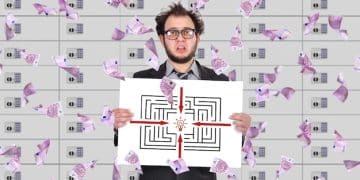Can Bankruptcy Help You Wipe Out Debt? Chapter 7 & 13 Explored

Bankruptcy can offer a path to debt relief, with Chapter 7 potentially discharging unsecured debts and Chapter 13 allowing for a repayment plan, but understanding the implications and eligibility requirements is crucial for making an informed decision.
Anúncios
Facing overwhelming debt can feel like an impossible burden. You might be wondering, can bankruptcy help you get out of debt? Understanding Chapter 7 and Chapter 13 Options could be your first step towards a fresh financial start.
Understanding Bankruptcy: An Overview
Bankruptcy is a legal process that offers individuals and businesses a chance to resolve overwhelming debt. It provides a framework to either liquidate assets to pay off creditors or create a repayment plan.
In the United States, the most common types of bankruptcy for individuals are Chapter 7 and Chapter 13. Each offers a different approach to debt relief, with varying eligibility requirements and outcomes.
Chapter 7 Bankruptcy: A Fresh Start Through Liquidation
Chapter 7 bankruptcy, often referred to as “liquidation bankruptcy,” allows debtors to discharge certain debts. In exchange, the bankruptcy trustee may sell off non-exempt assets to repay creditors.
While Chapter 7 provides a relatively quick path to debt relief, not everyone is eligible. Individuals must pass a means test to qualify.
The Means Test: Determining Eligibility
The means test is a calculation of your income and expenses to determine if you have the ability to repay your debts. If your income is below the state median, you generally qualify for Chapter 7. If it’s above, further calculations are needed.
Exempt vs. Non-Exempt Assets: What You Can Keep
Exempt assets are protected during bankruptcy and cannot be seized by the trustee. Each state has its own set of exemptions, which typically include things like a certain amount of home equity, personal belongings, and retirement accounts. Non-exempt assets, on the other hand, may be sold to repay creditors.
- Common Exemptions: Homestead exemption (equity in your primary residence), motor vehicle exemption, personal property exemption.
- Non-Exempt Examples: Investment accounts, vacation homes, valuable collectibles.
- State-Specific Laws: Exemptions vary widely by state, so it’s important to understand your local laws.
- Consult an Attorney: Bankruptcy attorneys can help you identify your exempt assets.
Chapter 7 can provide significant debt relief, but it’s crucial to understand the eligibility requirements and potential consequences. Properly assessing your assets and income is essential.
Chapter 13 Bankruptcy: Reorganization and Repayment
Chapter 13 bankruptcy involves creating a repayment plan over a period of three to five years. Debtors make regular payments to a trustee, who then distributes the funds to creditors.
Chapter 13 is often a good option for individuals who don’t qualify for Chapter 7 or want to protect assets, such as their home, from foreclosure.
Creating a Repayment Plan: How It Works
The repayment plan must be feasible and made in good faith. It must also provide creditors with at least as much as they would receive in a Chapter 7 liquidation.
Advantages of Chapter 13: Protecting Assets
One of the biggest advantages of Chapter 13 is the ability to keep your assets, especially your home. It can also allow you to catch up on missed mortgage payments and avoid foreclosure.
Discharging Remaining Debt: The End Result
Once you complete your repayment plan, any remaining dischargeable debt is wiped out. This can provide a clean slate and a chance to rebuild your financial future.
- Consistent Income: Requires a steady income to make regular payments.
- Secured Debt: Allows you to catch up on secured debts like mortgages and car loans.
- Dischargeable Debt: Only certain debts are dischargeable; others must be paid in full.
- Long-Term Commitment: Requires a commitment to make payments for 3-5 years.
Chapter 13 offers a structured path to debt repayment and asset protection. It requires discipline and a solid financial plan, but can lead to significant debt relief.
Key Differences Between Chapter 7 and Chapter 13
Choosing between Chapter 7 and Chapter 13 depends on your individual circumstances, income, assets, and goals. Understanding the core differences can help you make an informed decision.
Chapter 7 provides a faster path to debt discharge, while Chapter 13 offers more control over your assets and debts.
Income Requirements: The Means Test Revisited
Chapter 7 requires you to pass the means test, while Chapter 13 does not. If your income is too high to qualify for Chapter 7, Chapter 13 may be your only option.
Asset Protection: What’s at Stake?
Chapter 13 allows you to keep more of your assets, while Chapter 7 may require you to liquidate non-exempt assets.
Debt Discharge: What Debts Are Eligible?
Both Chapter 7 and Chapter 13 can discharge certain debts, but some debts are non-dischargeable in both types of bankruptcy. These include things like student loans, child support, and certain tax debts.
- Speed of Discharge: Chapter 7 offers a faster discharge (about 3-6 months).
- Repayment Plan: Chapter 13 involves a 3-5 year repayment plan.
- Debt Limits: Chapter 13 has debt limits, while Chapter 7 does not.
- Future Credit: Both can impact your credit, but Chapter 13 might allow for quicker rebuilding.
The choice between Chapter 7 and Chapter 13 is complex and depends heavily on your specific financial situation. Seeking professional legal advice is crucial.
The Bankruptcy Process: A Step-by-Step Guide
The bankruptcy process can seem intimidating, but understanding the steps involved can make it less overwhelming. Both Chapter 7 and Chapter 13 follow a similar general process.
From filing the initial paperwork to attending meetings with creditors, each step requires careful attention to detail.
Credit Counseling: The First Step
Before filing for bankruptcy, you must complete a credit counseling course from an approved agency. This course is designed to help you understand your options and make an informed decision.
Filing the Petition: Paperwork and Disclosures
The next step is to file a bankruptcy petition with the court. This petition includes detailed information about your income, assets, debts, and expenses.
Meeting of Creditors: Answering Questions
After filing, you’ll attend a meeting of creditors, also known as a 341 meeting. At this meeting, the trustee and creditors can ask you questions about your financial situation.
- Gather Documents: Collect all necessary financial documents, like tax returns, pay stubs, and bank statements.
- Complete Forms Accurately: Ensure all forms are filled out completely and accurately.
- Attend Hearings: Be prepared to attend all required hearings and meetings.
- Follow Court Orders: Comply with all court orders and deadlines.
Navigating the bankruptcy process requires careful planning and attention to detail. Working with experienced professionals can help you avoid costly mistakes.
Alternatives to Bankruptcy: Exploring Other Options
Bankruptcy is not the only solution to debt problems. Exploring alternatives can help you determine the best course of action for your situation.
From debt consolidation to credit counseling, various options can help you manage your debt without resorting to bankruptcy.
Debt Consolidation: Combining Multiple Debts
Debt consolidation involves taking out a new loan to pay off multiple existing debts. This can simplify your payments and potentially lower your interest rate.
Credit Counseling: Professional Guidance
Credit counseling agencies can help you create a budget, negotiate with creditors, and develop a debt management plan.
Debt Management Plans: Structured Repayment
A debt management plan involves making regular payments to a credit counseling agency, which then distributes the funds to your creditors.
Before considering bankruptcy, explore all available alternatives. These options may provide a less drastic and more sustainable solution to your debt problems.
| Key Concept | Brief Description |
|---|---|
| ✅ Chapter 7 | Liquidation of assets to discharge eligible debts. |
| 📅 Chapter 13 | Repayment plan over 3-5 years, allowing asset retention. |
| 💰 Means Test | Determines eligibility for Chapter 7 based on income. |
| 🤝 Alternatives | Debt consolidation, credit counseling, and debt management plans. |
Frequently Asked Questions
▼
Chapter 7 involves liquidating assets to pay off debts, while Chapter 13 involves creating a repayment plan over three to five years while retaining assets.
▼
The means test determines if your income is low enough to qualify for Chapter 7. If your income is too high, you may not be eligible.
▼
Non-dischargeable debts often include student loans, child support, alimony, and certain tax obligations, which must still be paid even after bankruptcy.
▼
Yes, Chapter 13 can allow you to keep your house by including mortgage payments in your repayment plan, helping you catch up on missed payments and avoid foreclosure.
▼
Alternatives include debt consolidation, credit counseling, and debt management plans, which can help manage debt without the need for bankruptcy.
Conclusion
Deciding whether to file for bankruptcy is a significant financial decision. Understanding the options available, such as Chapter 7 and Chapter 13, along with exploring potential alternatives, is crucial for making the best choice for your individual circumstances and paving the way toward financial recovery.







